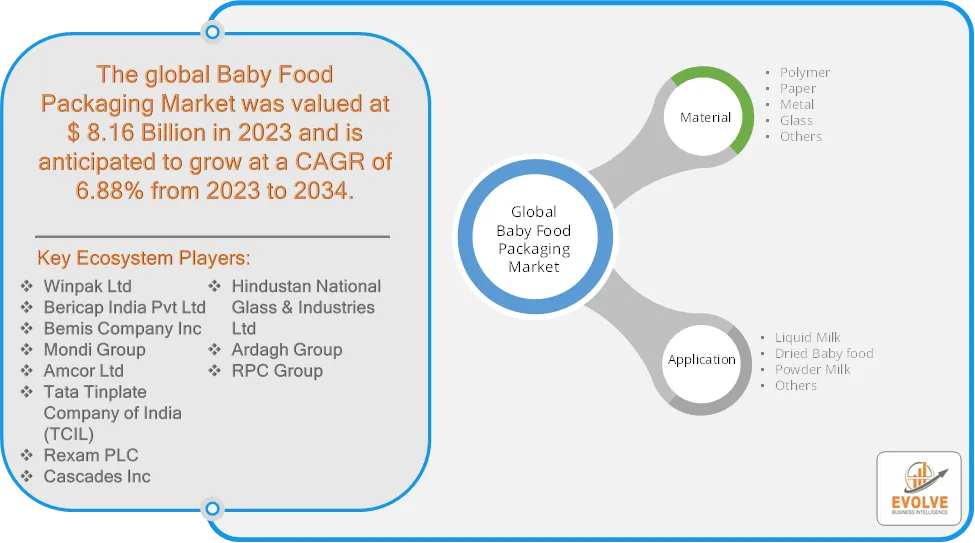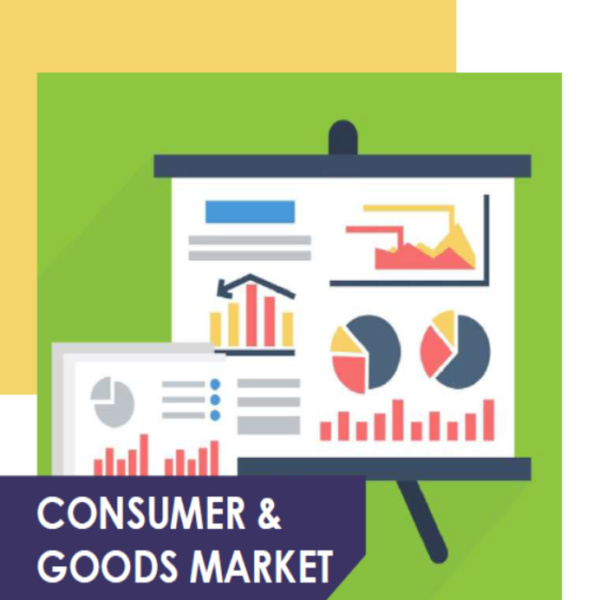Baby Food Packaging Market Overview
The Baby Food Packaging Market size accounted for USD 8.16 Billion in 2023 and is estimated to account for 9.66 Billion in 2024. The Market is expected to reach USD 11.85 Billion by 2034 growing at a compound annual growth rate (CAGR) of 6.88% from 2024 to 2034. The Baby Food Packaging Market focuses on the development and production of packaging solutions designed to ensure the safety, convenience, and longevity of baby food products. This market is driven by the increasing demand for ready-to-eat baby food, organic baby food products, and sustainable packaging solutions. Increased awareness of the importance of proper nutrition for infant development is driving demand for high-quality baby food and packaging.
The baby food packaging market is evolving to meet the demands of modern parents who prioritize safety, convenience, and sustainability. The demand for BPA-free, eco-friendly, and recyclable packaging has increased due to health-conscious consumers.
Global Baby Food Packaging Market Synopsis
 Baby Food Packaging Market Dynamics
Baby Food Packaging Market Dynamics
The major factors that have impacted the growth of Baby Food Packaging Market are as follows:
Drivers:
Ø Growing Demand for Convenience & Ready-to-Eat Baby Food
Increasing number of working parents is driving demand for ready-to-eat and easy-to-use baby food packaging. Portable, lightweight, and resealable packaging formats (pouches, squeeze tubes) are gaining popularity. Strict food safety regulations are pushing manufacturers toward BPA-free plastics, glass, and metal packaging. Growing focus on child-safe, leak-proof, and contamination-resistant packaging solutions. Use of QR codes, NFC tags, and augmented reality (AR) for tracking ingredients and verifying authenticity and extends shelf life by controlling oxygen and moisture levels.
Restraint:
- High Cost of Sustainable & Premium Packaging
Eco-friendly materials (biodegradable plastics, glass, metal) are more expensive than traditional plastic packaging. Costs associated with recyclable and reusable packaging development can affect profit margins. Higher logistics and transportation costs due to the weight of premium packaging (e.g., glass jars). Governments and consumers are pushing for plastic-free and biodegradable packaging, limiting the use of traditional materials. Challenges in establishing large-scale recycling infrastructure in emerging markets slow down sustainable packaging adoption.
Opportunity:
⮚ Rising Popularity of Smart & Intelligent Packaging
Adoption of QR codes, NFC tags, and RFID for product authenticity verification, traceability, and customer engagement. Use of Modified Atmosphere Packaging (MAP) and vacuum-sealed solutions to increase shelf life without preservatives. Growing interest in temperature-sensitive packaging that alerts consumers about storage conditions. The shift toward organic, non-GMO, and preservative-free baby food is driving demand for high-quality, specialized packaging. Luxury baby food brands are focusing on premium glass jars, metal cans, and resealable pouches for better product appeal. Opportunity to introduce customized, limited-edition, and aesthetically appealing packaging designs.
Baby Food Packaging Market Segment Overview
Based on material, the market is segmented based on Polymer, Paper, Metal, Glass, Others. The Polymer segment in the Baby Food Packaging market is poised for substantial growth throughout the forecast period, driven by its inherent versatility and adaptability to innovative packaging designs. Polymer materials, including polyethylene, polypropylene, and polyethylene terephthalate, offer lightweight, durable, and cost-effective solutions, aligning with the industry’s emphasis on convenience and sustainability. This segment’s growth is further fueled by the continuous development of advanced polymer technologies, enabling the creation of safe and secure packaging solutions that cater to the evolving demands of parents for efficient and eco-friendly baby food packaging.
By Application
Based on Application, the market segment has been divided into the Liquid Milk, Dried Baby food, Powder Milk and Others. The Liquid Milk segment in the Baby Food Packaging market is poised for substantial growth during the forecast period, attributed to increasing consumer preferences for convenient and on-the-go baby feeding solutions. As demand rises for ready-to-use liquid milk products, the packaging industry is innovating with user-friendly, sterile, and portion-controlled packaging designs, driving the popularity of this segment among parents seeking convenient and nutritionally sound options for their infants.
Global Baby Food Packaging Market Regional Analysis
Based on region, the global Baby Food Packaging Market has been divided into North America, Europe, Asia-Pacific, the Middle East & Africa, and Latin America. North America is projected to dominate the use of the Baby Food Packaging Market followed by the Asia-Pacific and Europe regions.

North America Global Baby Food Packaging Market
North America holds a dominant position in the Baby Food Packaging Market. It’s driven by busy lifestyles and a high demand for convenient packaging solutions. There’s a strong emphasis on product innovation, safety, and extending shelf life and consumers are increasingly seeking organic and premium baby food products, influencing packaging trends. There is also a strong push for sustainable packaging.
Asia-Pacific Global Baby Food Packaging Market
The Asia-Pacific region has indeed emerged as the fastest-growing market for the Baby Food Packaging Market industry. Asia-Pacific region is experiencing rapid growth due to rising disposable incomes, increasing birth rates, and urbanization. E-commerce plays a significant role in expanding market reach. There’s a growing demand for packaged baby food as a convenient alternative to homemade meals. China and India are key markets within this region.
Competitive Landscape
The global Baby Food Packaging Market is highly competitive, with numerous players offering a wide range of software solutions. The competitive landscape is characterized by the presence of established companies, as well as emerging startups and niche players. To increase their market position and attract a wide consumer base, the businesses are employing various strategies, such as product launches, and strategic alliances.
Prominent Players:
- Winpak Ltd
- Bericap India Pvt Ltd
- Bemis Company Inc
- Mondi Group
- Amcor Ltd
- Tata Tinplate Company of India (TCIL)
- Rexam PLC
- Cascades Inc
- Hindustan National Glass & Industries Ltd
- Ardagh Group
- RPC Group.
Scope of the Report
Global Baby Food Packaging Market, by Material
- Polymer
- Paper
- Metal
- Glass
- Others
Global Baby Food Packaging Market, by Application
- Liquid Milk
- Dried Baby food
- Powder Milk
- Others
Global Baby Food Packaging Market, by Region
- North America
- US
- Canada
- Mexico
- Europe
- UK
- Germany
- France
- Italy
- Spain
- Benelux
- Nordic
- Rest of Europe
- Asia Pacific
- China
- Japan
- South Korea
- Indonesia
- Austalia
- Malaysia
- India
- Rest of Asia Pacific
- South America
- Brazil
- Argentina
- Rest of SouthAmerica
- Middle East &Africa
- Saudi Arabia
- UAE
- Egypt
- SouthAfrica
- Rest of Middle East & Africa
| Parameters | Indicators |
|---|---|
| Market Size | 2033: USD 32.88 Billion |
| CAGR (2023-2033) | 10.96% |
| Base year | 2022 |
| Forecast Period | 2023-2033 |
| Historical Data | 2021 (2017 to 2020 On Demand) |
| Report Coverage | Revenue Forecast, Competitive Landscape, Growth Factors, and Trends |
| Key Segmentations | Material, Application |
| Geographies Covered | North America, Europe, Asia-Pacific, South America, Middle East, Africa |
| Key Vendors | Winpak Ltd, Bericap India Pvt Ltd, Bemis Company Inc, Mondi Group, Amcor Ltd, Tata Tinplate Company of India (TCIL), Rexam PLC, Cascades Inc, Hindustan National Glass & Industries Ltd, Ardagh Group and RPC Group. |
| Key Market Opportunities | · Rising Popularity of Smart & Intelligent Packaging
· Growth of Organic & Premium Baby Food |
| Key Market Drivers | · Growing Demand for Convenience & Ready-to-Eat Baby Food
· Rising Health & Safety Concerns |
REPORT CONTENT BRIEF:
- High-level analysis of the current and future Baby Food Packaging Market trends and opportunities
- Detailed analysis of current market drivers, restraining factors, and opportunities in the future
- Baby Food Packaging Market historical market size for the year 2021, and forecast from 2023 to 2033
- Baby Food Packaging Market share analysis at each product level
- Competitor analysis with detailed insight into its product segment, Government & Defense strength, and strategies adopted.
- Identifies key strategies adopted including product launches and developments, mergers and acquisitions, joint ventures, collaborations, and partnerships as well as funding taken and investment done, among others.
- To identify and understand the various factors involved in the global Baby Food Packaging Market affected by the pandemic
- To provide a detailed insight into the major companies operating in the market. The profiling will include the Government & Defense health of the company’s past 2-3 years with segmental and regional revenue breakup, product offering, recent developments, SWOT analysis, and key strategies.










